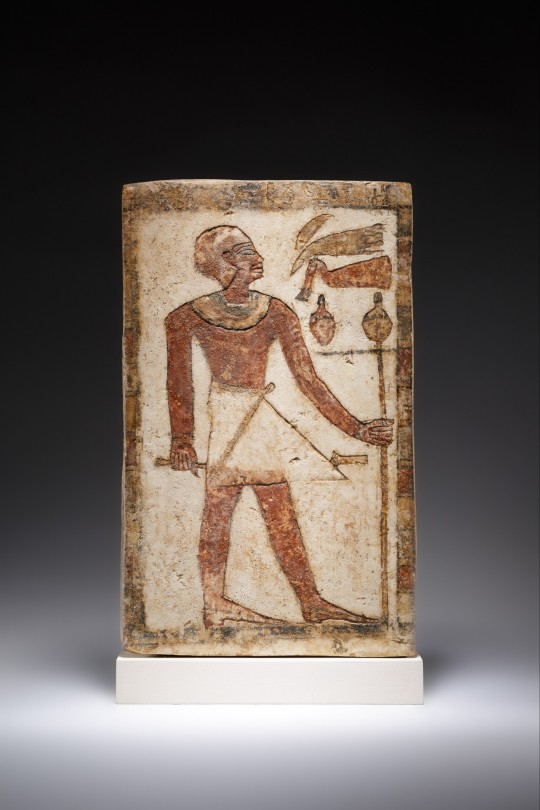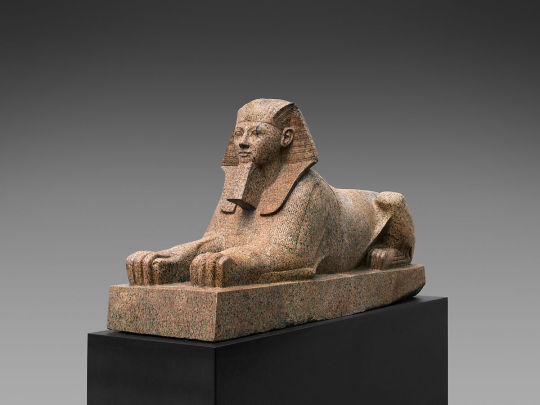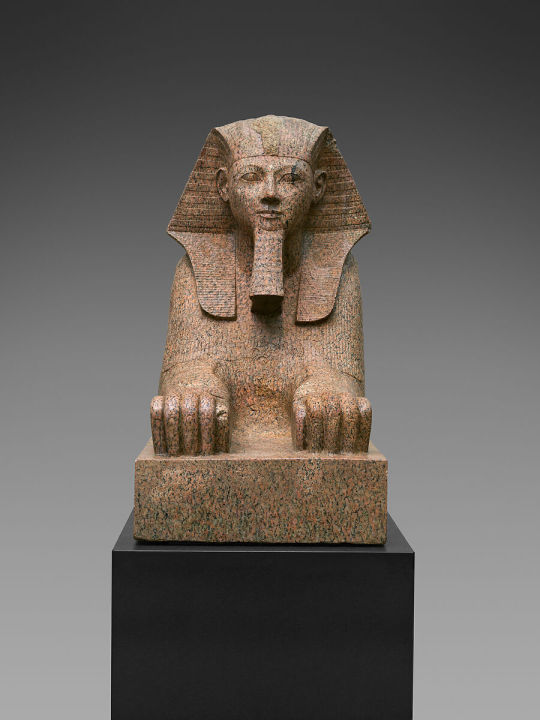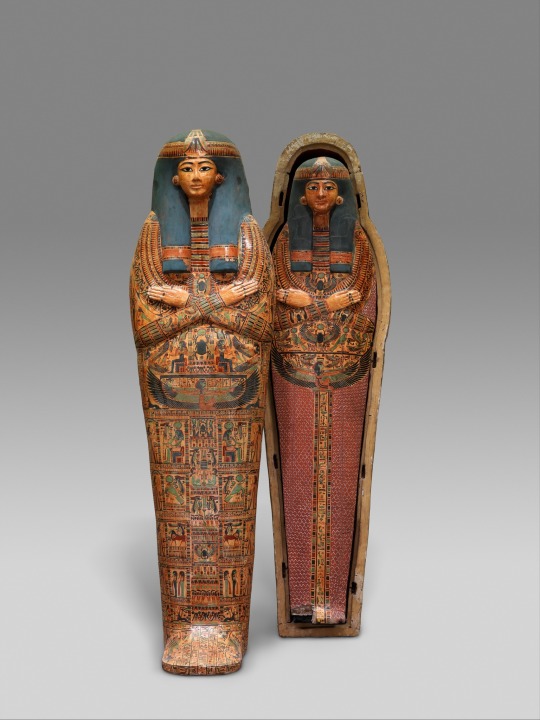#deir el-bahri
Explore tagged Tumblr posts
Text

Partial statue of the 18th Dynasty pharaoh Thutmose III (r. 1479-1425 BCE). Found at Deir el-Bahri; now in the Egyptian Museum, Cairo. Photo credit: Prof. Mortel/Wikimedia Commons.
#art#art history#ancient art#Egypt#Ancient Egypt#Egyptian art#Ancient Egyptian art#18th Dynasty#New Kingdom#Thutmose III#statue#sculpture#portrait sculpture#Deir el-Bahri#Egyptian Museum Cairo
142 notes
·
View notes
Text

A Necklace of four strands of beads and amulets - Met Museum Collection
Inventory Number: 22.3.324 Middle Kingdom, Dynasty 11, ca. 2051–2030 B.C. Location Information: From Egypt, Upper Egypt, Thebes, Deir el-Bahri, Tomb of Myt, Temple of Mentuhotep II, Pit 18, mummy of Myt, MMA excavations, 1921
Description:
This brightly colored set of necklaces belonging to a young girl are remarkable not only for their technically brilliant manufacture, the drilled stone beads being quite tiny.
Mayet was only five when she was buried among the older female members of the King Mentuhotep II’s court in his funerary complex at Deir el Bahri. Although her burial was simple, her necklaces, including two others of gold and carnelian ball beads, are some of the finest jewelry that survives from this period and the signs of wear on the beads indicate Mayet, or perhaps another woman, wore them during their lifetime.
#A Necklace of four strands of beads and amulets#necklace#necklaces#jewelry#middle kingdom#dynasty 11#upper egypt#thebes#deir el-bahri#deir el bahri#tomb of myt#temple of mentuhotep II#met museum#22.3.324#MKJ
9 notes
·
View notes
Text

Deir el Bahri June 29, 2023
118 notes
·
View notes
Note
Can you find/share a quote that describes where Abdullah meets Amelia in her dreams? I think it’s the cliffs above Deir el Bahri and they look to the east - she describes a sunrise at one point I’m pretty sure.
I’m playing Assassin’s Creed Origins which takes place in Egypt in Cleopatra’s time and I wanted to visit some Peabody locations 🙃
Yep, Deir el Bahri!
"As I neared the top of the cliff I looked up to see a tall, familiar form silhouetted against the pale blue of the early-morning sky. I was in Luxor again, climbing the steep path that led to the top of the plateau behind Deir el Bahri, and Abdullah was waiting. ... Instead of vanishing into the depths of sleep, as he and his surroundings had done before, he turned and walked away. He did not stop or look back as he followed the long path that led to the Valley where the kings of Egypt had been laid to rest." - He Shall Thunder in the Sky
I haven't posted from post-Ape books yet, but whenever I post a quote where Amelia is describing a place in Egypt, I use the tag "amelia describes egypt" (it's very clever lol).
2 notes
·
View notes
Text
I'm to be cremated and half my ashes taken to be scattered at my family cottage in Muskoka, Canada and the other half are to be scattered at the temple of Deir el Bahri in Egypt.
#I'm to be cremated and half my ashes taken to be scattered at my family cottage in Muskoka#Canada and the other half are to be scattered at the temple of Deir el Bahri in Egypt.
28K notes
·
View notes
Text

~ Stela of a Man.
Period: Middle Kingdom, 11th Dynasty
Date: ca. 2030–1981 B.C.
Place oforigin: Egypt, Upper Egypt, Thebes, Deir el-Bahri, Cemetery 100, Tomb TT 114, MMA excavations, 1926–27
Medium: Limestone, paint
#ancient#ancient art#history#museum#archeology#ancient egypt#ancient sculpture#ancient history#archaeology#egyptian#egyptology#Egypt#stela of a man#11th Dynasty#middle kingdom#thebes#ca. 2030 b.c.#ca. 1981 b.c.
634 notes
·
View notes
Photo



Sphinx of Hatshepsut New Kingdom. Dynasty 18. Ca. 1479–1458 B.C. Granite. H: 164 cm (64 9/16 in.); L: 343 cm (135 1/16 in.); Wt: 6758.6 kg (14900 lb.).
This colossal sphinx portrays the female pharaoh Hatshepsut with the body of a lion and a human head wearing a nemes–headcloth and false beard. The sculptor has carefully observed the powerful muscles of the lion as contrasted to the handsome, idealized face of the pharaoh. It was one of at least six granite sphinxes that stood in Hatshepsut's mortuary temple at Deir el-Bahri.
The Met Fifth Avenue in Gallery 131.
#Sphinx of Hatshepsut#New Kingdom#Dynasty 18#Ca. 1479–1458 B.C#granite sculpture#ancient artifacts#archeology#archeolgst#history#history news#ancient history#ancient culture#ancient civilizations#ancient egypt#egyptian history#egyptian art#the met fifth avenue
303 notes
·
View notes
Text

Statues of Hatshepsut
Metropolitan Museum of Art, Egyptian Art Collection
On view at The Met Fifth Avenue in Gallery 115
Period: New Kingdom
Dynasty: Dynasty 18
Reign: Joint reign of Hatshepsut and Thutmose III
Date: ca. 1479–1458 B.C.
Geography: From Egypt, Upper Egypt, Thebes, Deir el-Bahri, Senenmut Quarry, MMA excavations, 1927–28
Medium: Granite
Dimensions: H. 261.5 cm (102 15/16 in.); W. 80 cm (31 1/2 in.); D. 137 cm (53 15/16 in.)
Accession Number: 29.3.1, 30.3.1
7 notes
·
View notes
Text

There was once a land so rich and mysterious that it was hailed as a paradise by ancient pharaohs, yet today its exact location remains one of history's tantalizing enigmas.
This is the ancient land of Punt, often referred to as 'God's Land' by the Egyptians. Famed for its wealth in gold, incense, and exotic wildlife, Punt was the center of a bustling trade network thousands of years ago.
However, despite its once-celebrated status, it mysteriously vanished from historical records, leaving academics and adventurers seeking to rediscover its lost splendor.
The knowledge of Punt and its history is primarily derived from ancient Egyptian sources, as they were the most prolific record-keepers of their interactions with this mysterious land.
The most vivid and informative of these records are the temple reliefs found in Deir el-Bahri, part of the mortuary temple of Queen Hatshepsut.
These reliefs depict the famous expedition to Punt commissioned by Hatshepsut around 1490 BCE, providing detailed images of the Puntite people, their houses on stilts, and the goods brought back to Egypt, including gold, ebony, myrrh, and living incense trees.
There was once a land so rich and mysterious that it was hailed as a paradise by ancient pharaohs This is the ancient land of Punt, often referred to as 'God's Land' by the Egyptians. Famed for its wealth in gold, incense, and exotic wildlife, Punt was the center of a bustling trade network thousands of years ago.
This shift could have been exacerbated by the rise of other trading powers in the region, which offered similar or more accessible commodities.
The economic decline, as a result of these shifting trade dynamics, could have led to a gradual fading of Punt from the prominent position it once held.
Additionally, there is speculation that internal societal changes within Punt itself, such as political upheaval or social unrest, might have contributed to its decline.
The lack of direct historical records from Punt makes it challenging to ascertain the nature of its political and social structures, but like many civilizations, it is conceivable that internal factors played a role in its eventual disappearance.
Some scholars also consider the possibility that the decline of the Egyptian Empire, which was a major trading partner of Punt, could have had a significant impact.
As Egypt's power and wealth waned, its ability to undertake expansive trading expeditions like those to Punt would have diminished, thereby reducing one of Punt's key economic lifelines
10 notes
·
View notes
Text

“Bottle From Dra Abu el-Naga, Lower Cemetery, tomb 44
Dynasty 18 (1539-1292 B.C.E.)
Ceramic, 23 x 11.7 cm max. diam. (9 × 4⅝ in.)
Coxe Expedition, 1922
29-87-197
Round-based slender bottles such as this example are paralleled at sites of the early New Kingdom.' They are often found in cemetery contexts, deposited as part of burial furnishings,' as was this bottle. It is made from an alluvial clay, and the surface has been red slipped and burnished, probably with a pebble, resulting in the distinctive vertical polished lines on the surface. Three small spots of discoloration on the body likely resulted when the bottle touched another vessel in the kiln during firing.
This bottle was excavated in 1922 by Clarence Fisher from tomb 44 in the Lower Cemetery at Dra Abu el-Naga, on the west bank at Thebes just north of Deir el-Bahri. Tomb 44 consisted of a shaft and three chambers cut from the bedrock. It contained pottery from both the Middle and New Kingdoms, indicating use in both periods,' as was the case for most tombs at the site.
- MDA”
26 notes
·
View notes
Text
Hatshepsut and the Temple of Luxor
Greetings from the fabulous boat traveling up the Nile.
The actual date is Sept 26 - but sadly I’m still writing about September 22. After we visited the Valley of the Kings we drove around the valley to another valley to find the back door entrance to the Temple of Queen Hatshepsut - Egypt’s first know female monarch. She ruled for 20 years in the 15th BCE and is considered one of Egypts’ most successful pharaohs. Now Hatshepsut (pronounced "Hat- cheep- suit" - not how I had learned earlier “hot shit soup”) did NOT want to be buried in the Valley of the Queens - but in the Valley of the Kings.

Her tomb connected the building below with an entrance in the Valley of the Kings. Think about that for a minute. The engineers connected a tomb through the mountains. She secured her legacy by building structures that still stand today. She added two hundred-foot-tall obelisks at the great temple complex at Karnak. (One is still intact and we saw in on that very, very hot day exploring Karnak) She also built the mortuary Temple of Deir el Bahri, a structure with several floors of columns in front, where she’d eventually be buried. Here is what we saw:




Considered one of Egypt's greatest pharaohs—man or woman—Hatshepsut brought great wealth and artistry to her land. She sponsored one of Egypt's most successful trading expeditions, bringing back gold, ebony, and incense from a place called Punt (probably modern-day Eritrea, a country in Africa).

Available for your viewing in the NY Metropolitan Museum of Art.
Hatshepsut was usually carved or drawn as a man, complete with muscles and a beard, as was the artistic tradition for pharaohs. But historians knew the truth: She always made sure the art included a reference to being a woman, such as “Daughter of Re” or “His Majesty, Herself.” When she died in 1458 B.C., Egypt would not see as powerful a female ruler for another 1,400 years, when Cleopatra came to the throne.
After we saw Hatshepsut’s impressive tomb we headed back to our hotel for some R&R. But that evening, we were at it again and this time exploring the Temple of Luxor.
AGAIN - WOWZA!!!
From the official webpage:
Luxor Temple, Ipet-resyt “Southern Sanctuary” to the ancient Egyptians, was so called because of its location within ancient Thebes (modern Luxor). It is located around three kilometers to the south of Karnak Temple, to which it was once linked with a processional way bordered with sphinxes. The oldest evidence for this temple dates to the Eighteenth Dynasty (c.1550–1295 BC).
Ipet-resyt, unlike most other ancient Egyptian temples, is not laid out on an east-west axis, but is oriented towards Karnak. This is because Luxor Temple was the main venue for one the most important of ancient Egyptian religious celebrations, when the cult images of Amun, his wife Mut, and their son, the lunar god Khonsu, were taken from their temples in Karnak, and transported in a grand procession to Luxor Temple so they could visit the god that resides there, Amenemopet. This was the Opet Festival.
Luxor Temple was not built by one single ruler. The oldest existing structure, a shrine, dates to the reign of Hatshepsut (c.1473–1458 BC). The core of the temple was built by Amenhotep III (c.1390–1352 BC). One of the inner rooms contains a series of scenes that are known as the Divine Birth. They tell the amazing story of how the king’s true father was none other than the god Amun-Ra himself, disguised as Thutmose IV (c.1400–1390 BC). The core of the temple is preceded by a columned hall fronted by a courtyard with columns around its perimeter. Amenhotep III also built the Great Colonnade, which consists of two rows of seven colossal columns. Its decoration, most notably the scenes depicting the Opet Festival, were completed by Tutankhamun (c.1336–1327 BC) and Horemheb (c.1323–1295 BC).
Ramesses II (c.1279–1213 BC) made many additions to Luxor Temple. In front of the Great Colonnade, he built a peristyle courtyard and a massive pylon, a gate with two towers that formed the entrance into temples. In addition to many colossal statues, the pylon was also fronted by a pair of 25-meter-high obelisks made by this great king, but only one remains in place; the other has been at the Place de la Concorde in Paris since 1836.
In the late third century AD, the Romans built a fort around the temple, and the first room beyond the hypostyle hall of Amenhotep III became its sanctuary. The original wall reliefs were covered with plaster, and painted in the Graeco-Roman artistic style, depicting Emperor Diocletian (284–305 AD) and his three coregents. Although these had largely disappeared, efforts are under way to restore these reliefs to their former glory.
This magnificent city was covered deep in mud until the 1860s. Take a look at these photos:



Here is the one I took:
Likewise the 1.7 mile road that connected this temple to Karnak, Avenue of the Spinxes was also buried.


The first trace of the avenue (at Luxor) was found in 1949 when an Egyptian archaeologist discovered eight statues near the Luxor Temple with 17 more statues uncovered from 1958 to 1961 and 55 unearthed from 1961 to 1964 all within a perimeter of 250 meters. From 1984 to 2000, the entire route of the walkway was finally determined, leaving it to excavators to uncover the road. The original 1,057 statues are along the way, and they are divided into three shapes;
The first shape is a lion's body with a ram's head erected on an area of approximately 1,000 feet between the Karnak temple and the Precinct of Mut during the reign of the ruler of the New Kingdom Tutankhamun.
The second shape is a full ram statue, built in a remote area during the eighteenth dynasty of Amenhotep III, before being transferred later to the Karnak complex.
The third shape which includes the largest part of the statues is a statue of the Sphinx (body of a lion and head of a human), the statues extend over a mile to Luxor Temple.
Here are those shapes:



Cool huh? While I was researching Temple of Luxor, I discovered a 3 minute video by Rick Steves about Karnak. It is truly worth your time.
youtube
I LOVED this temple! It was evening, temps in the high 80s and we had complete shade - and MAYBE that had something to do with it - but it was just so fabulous. This temple - like all religious sites of significance - was built upon. There exists a working Mosque and a former church with the ground of the temple. Check out the Mosque to fully understand just how deeply this temple was buried. There was no basement here friends.

Here is what is left of the church.

Some of the best statues were found there - I thought…



Above is an indication of the Pharoah’s power. Captives from many regions.
And while we were there a Scarab Beetle landed on our friend, Keith’ shirt. A CERTAIN sign of good luck.

It was a great visit…

Here is a 3 minute video - no words - but it gives you a great look at what we saw. Enjoy.
youtube
Tomorrow - we start the day with a hot air balloon ride and then drive to our boat. WHAT A TRIP!!!
Salam
2 notes
·
View notes
Text

Book of the Dead for the Chantress of Amun Nauny - Met Museum Collection
Inventory Number: 30.3.31 Third Intermediate Period, Dynasty 21, ca. 1050 B.C. Location Information: From Egypt, Upper Egypt, Thebes, Deir el-Bahri, Tomb of Meritamun (TT 358, MMA 65), burial of Nauny, first corridor, inside Osiris figure, MMA excavations, 1928–29
Description:
This papyrus was part of the burial of Nauny, a Chantress of the god Amun-Re who died in her seventies. She also bore the title "king's daughter," which probably means that she was a child of the High Priest of Amun and titular king of the Theban area, Painedjem I.
On the papyrus are images and texts from a number of spells. The central scene illustrates Spell 125, better known as the Judgment of Osiris or The Weighing of the Heart. Nauny is in the Hall of Judgment. (...) Behind Nauny stands the goddess Isis, both wife and sister of Osiris. She is identified by the hieroglyph above her head.
#Book of the Dead for the Chantress of Amun Nauny#third intermediate#dynasty 21#upper egypt#thebes#deir el bahri#deir el-bahri#tomb of meritamun#met museum#30.3.31#womens clothing#TIWC#deities#deitiesw#aset
6 notes
·
View notes
Text


Deir el-Bahri | June 2023
#mine#I hope people behave since I'm posting original photos again#ancient egypt#egyptology#egyptian archaeology
19 notes
·
View notes
Photo

Winged Scarab by Heidi Kontkanen Via Flickr: “Detail from the Anthropoid coffin of the priest Ankhefenkhonsu. He was a high priest in the temple of Montu. One of his titles was the master of Thebes. 25th dynasty, from Deir el-Bahri CG 41042 Upper floor, gallery 21 Cairo Museum “
[On a white Egyptian coffin, a blue scarab, its body edged with gold, rolls a red sun-disc upwards. It has wings with blue and yellow feathers. Closest to its head the feathers are a yellow field with white spots, beneath which the feathers are yellow and green. There’s a shen-ring between its hind legs.]
23 notes
·
View notes
Text

Tablero de momias del cantante de Amun-Re, Henettawy, ca. 1000–945 a. C. Tercer Período Intermedio De Egipto, Alto Egipto, Tebas, Deir el-Bahri, Tumba de Henettawy F (MMA 59), excavaciones de MMA, 1923–24 El Museo Metropolitano de Arte
33 notes
·
View notes
Text
Egyptian Archer

This is my portrayal of an ancient Egyptian archer. In the Egyptian military, archers could be indigenous Egyptians (aka Kemetians) like this gentleman here or mercenaries hired from the “Land of the Bow” (or what we now call Nubia) further up the Nile. In either case, their bows would have been what are called self bows, or bows made from one piece of wood, before the Hyksos brought in the composite bow (made from multiple pieces of wood) when they invaded northern Egypt from the Middle East around 1700 BC.
The white diagonal straps over this Egyptian archer’s body are referenced from an Old Kingdom tomb relief that probably came from the Giza area, and his basket-like quiver is based on one from the Middle Kingdom uncovered at the site of Deir el-Bahri near modern Luxor. In retrospect, the arrow came out longer than I intended, but I suppose really long arrows could have always existed.
#ancient egypt#egyptian#kemet#african#black man#dark skin#bipoc#poc#history#ancient#archery#digital art#art
6 notes
·
View notes